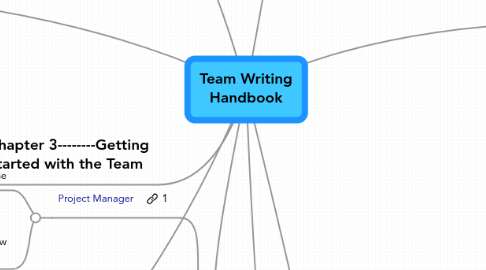
1. Chapter 2 John
1.1. Project Manager
1.1.1. Purpose
1.1.1.1. Produces Documents
1.1.1.2. Task Shedule
1.1.1.3. Creates Deadlines
1.1.2. Starts Process with a Straw Document
1.2. Deadlines
1.2.1. Meeting agendas
1.3. Meeting minutes and accountability
1.3.1. Dangers of operation without minutes
1.3.1.1. Waste time
1.3.1.2. proceed without consensus
1.3.1.3. Forget Details
1.3.1.4. Encourage Slackers
2. Chapter 3--------Getting Started with the Team
2.1. Team Charter
2.2. Team Goals
2.2.1. Measurable Goals
2.2.2. Personal Goals
2.3. Individual Commitment: What kind of effort will each invest?
2.4. Negative factors
2.4.1. Irreconcilable differences
2.4.2. Late Work
2.4.3. Unacceptable Work
2.5. Putting it all together
3. Online To-Do List
3.1. www.listmoz.com
3.1.1. No account sign in necessary
3.1.2. Easy to edit & arrange
3.1.3. Assigns a web address to the list: return, share, save
3.1.4. After checking off completed goal the list remains below as completed.
3.1.5. The list could effectively show how many completed goals as a way to measure goals.
4. Chapter 4: Getting Started with the task schedule
4.1. Identifying Major Tasks
4.2. Assigning Major Roles: Motivation vs Experience
4.2.1. Gender division in labor
4.2.2. Primary task
4.2.3. Secondary task
4.3. HTW Related content
4.3.1. Research and Outlining
4.3.2. Planning
4.4. Scheduling the Task
4.5. Balancing the work task
4.6. Technology & Tools for Task Schedules
4.7. Online Calendar
5. Chapter 5 - Constructive Conflict
5.1. Engaging in Constructive conflict
5.1.1. Present evidence and reasons in support of their ideas
5.1.2. Listen closely to other view points
5.1.3. Carefully consider the merits and drawbacks of all opinions presented
5.1.4. Work towards a solution by building and imporving on all ideas presented
5.2. Five Key Strategies
5.3. another helpful website
5.4. HTW Related Topics
5.4.1. Conflict
5.4.2. Consensus
6. Chapter 6 Revising with Others
6.1. Developing Culture: Encouraged Constructive Feedback
6.1.1. Build revision and feedback into task schedule.
6.1.2. Decide on a revision process & follow it
6.1.3. Use writing software that keeps a history of revision
6.1.4. Include a statement about the importance of revision and feedback in the team charter
6.2. Two types if Revision
6.2.1. Feedback
6.2.2. Direct Revision
6.3. Ground Rules
6.3.1. clarify the state of the draft
6.3.2. Clarify the goals of the revision or feedback
6.4. Providing Effective Feedback & Making Good Revisions
6.4.1. Review he assignment instruction sheet (make a checklist of the criteria)
6.4.2. Check against the grading rubric
6.4.3. Review team charter
6.5. Listening and Negotiating
6.6. Technology
6.6.1. e-mail
6.6.2. Google docs
6.6.3. Wikis
6.6.4. Gliffy
6.7. HTW Related
7. Chapter 8 - Trouble Shooting Team Problems
7.1. Not showing up and turning in work
7.1.1. Missing Meetings
7.1.2. Missing a deadline
7.1.3. Incomplete work
7.1.4. Poor Quality Work
7.1.5. Completely disappears
7.2. Problems with personal interactions
7.2.1. Trust among the team
7.2.2. Team doesn't listen
7.2.3. Other team members are not commited
7.2.4. Team mates saying demeaning things
7.3. Problems with revison
7.3.1. Not open to revison
7.3.2. My team is destroying my work
7.3.3. Not giving adequate feedback
7.3.4. Not sure how to give feedback
7.4. Related HTW
7.4.1. Collaborative Writing Checklist
7.4.1.1. Designate a team coordinator
7.4.1.2. Identify the audience, purpose, context and scope of the project
7.4.1.3. Create a project plan, including a schedule and standards
7.4.1.4. create a working outline of the document
7.4.1.5. Assign segments or tasks to each member of the team
7.4.1.6. Research and write drafts of document segments
7.4.1.7. Follow the schedule: due dates for drafts, revisions and final versions
7.4.1.8. Use the agreed-upon standards for style and format
7.4.1.9. Exchange segments for team member reviews
8. chapter 1 Georgia
8.1. Why Teamwork?
8.1.1. Prepare Students for workplace
8.1.2. Employers want to hire experienced people who know how to collaborate
8.1.3. Saves time and money
8.1.4. Learn from peers
8.1.5. Motivation by others
8.1.6. Learn by teaching others
8.2. Understanding Collaboration Methods
8.2.1. Face-to-Face
8.2.1.1. team writes together
8.2.2. Divided
8.2.2.1. Group breaks docs into sections
8.2.3. Layered
8.2.3.1. Each is assigned roles
8.2.3.2. each add to the product
8.2.3.3. accumulates in layers
8.3. Alternating Collaboration Methods
8.4. Related Internet Sites
8.4.1. http://www.io.com/~hcexres/textbook/team.html#teamwriting
8.4.2. http://www.allbusiness.com/human-resources/employee-development-team-building/339377-1.html
8.5. HTW Related topics
8.5.1. Teams are formed when:
8.5.1.1. size requires more people because of time restraints
8.5.1.2. requires multiple areas of expertise
8.5.1.3. melding of divergent views
9. Chapter 7 - Communication Styles and Team Diversity
9.1. The Benefits of a Diverse team
9.2. Differences in norms cause interpersonal conflict
9.2.1. Understanding norms
9.2.1.1. Individual Norn
9.2.1.2. Communication Norm
9.2.2. Competitive versus considerate conversational norms
9.2.2.1. Competitive
9.2.2.1.1. Learn how over come the competitive speaker with strategy
9.2.2.2. Hierarchical
9.2.2.3. Considerate
9.2.2.4. Back Channeling
9.2.3. Gender and Communication Norms
9.3. Self-promoting versus self deprecating-speech
9.3.1. Action Oriented Vs Holistic Probem Solving
9.3.1.1. Social Rules
